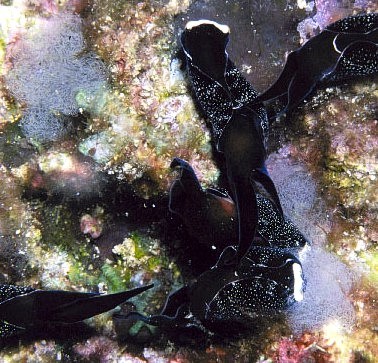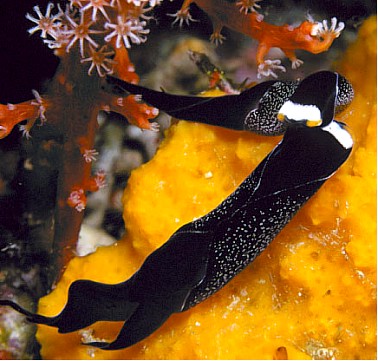Chelidonura inornata: mating & trail-following
January 25, 2000
From: M. J. Adams


Dear Bill,
I was diving on top of a sea mount in the Solomon Islands when I came across a group of Chelidonura inornata mating and laying eggs. [white patches in photo to right are egg masses with strings of microscopic white eggs].
Nearby was an orange sponge. I was hoping one of the slugs would crawl over the sponge so I could get a photo of it with a contrasting background. To my delight, within a few minutes several C. inornata sped across the sponge, obviously following some unobservable trail. Two slugs that came from opposite directions turned toward each other and, upon contact, instantly wrapped around each other. A slug of another species, Chelidonura electra also traversed the sponge, apparently following the same mucous trail. This all happened within a few minutes.
Has anyone studied sea slug slime? It seems to me that it must contain something like a pheromone that has a very strong attraction for Chelidonura species.
Divesite: "Tuhlagi Twin Tunnels, a coral reef in the Florida Group of the Solomon Islands, 12 meters, November 24, 1999.
The Sea Slug Forum has accumulated an amazing amount of information in a short period of time. What a great way to share experiences from branchophiles all over the world!
Thanks!
Mary Jane Adams
mjadams@earthlink.net
Adams, M.J., 2000 (Jan 25) Chelidonura inornata: mating & trail-following. [Message in] Sea Slug Forum. Australian Museum, Sydney. Available from http://www.seaslugforum.net/find/1776Dear Mary Jane,
Thanks for the great photos and observations. The almost 'instantaneous' mating behaviour when aglajids make contact may be an important behaviour to ensure mating amongst animals that can't see each other or call to each other. Most species of aglajids that I have collected in numbers immediately start mating when kept in confined quarters, such as a collecting jar. I've often tipped out mating chains of 4 or more animals.
Aglajids are all hunting carnivores and I have summarised some of the information in my comments below on a message from Erik Schloegl. Have a look at the Top of Page for a photo of the sensory bristles all aglajids have for following mucus trails. There is also general biological information on the general Chelidonura page and evidence, which unfolded on the Forum, to show at last that species of Chelidonura feed on flatworms.
The first comprehensive study of an aglajid hunting its prey by following mucous trails was Bob Paine's work on Navanax inermis. He showed its specialised feeding on sea slugs, both nudibranchs and bubble-shells. he also showed that when Navanax came across a mucous trail it was just as likely to go the wrong way down the trail.
-
Paine, R.T. (1963) Food Recognition and Predation on opisthobranchs by Navanax inermis. The Veliger, 6(1): 1-9.
Best wishes,
Bill Rudman.
Related messages
-
Chelidonura inornata feeding?
From: Leanne & David Atkinson, March 29, 2007 -
Re: Chelidonura inornata in sthn NSW
From: Francis Hawkshaw, March 15, 2006 -
Chelidonura inornata from sthn New South Wales
From: Francis Hawkshaw, March 13, 2006 -
Chelidonura inornata from Townsville, Australia
From: Paul Osmond, January 25, 2004 -
Chelidonura inornata from Line islands, Kiribati
From: Don Barclay, May 31, 2003 -
Chelidonura inornata from Lord Howe Island
From: W.B. Rudman, January 9, 2003 -
Chelidonura inornata from nthn New South Wales
From: John Pogonoski, August 16, 2002 -
Chelidonura inornata from the Line Islands
From: Cory Pittman, October 24, 2001 -
Chelidonura behaviour
From: Jeanette McInnes, October 10, 2001 -
Chelidonura inornata from Coral Sea
From: Des Paroz, October 19, 2000 -
Chelidonura inornata feeding?
From: Akos Lumnitzer, June 8, 2000 -
Chelidonura inornata - mating photo
From: Mary Jane Adams, January 30, 2000 -
feeding? observations - Chelidonura inornata
From: Erik Schloegl, September 20, 1999 -
Chelidonura from Mooloolaba
From: Wayne Ellis, June 20, 1998
